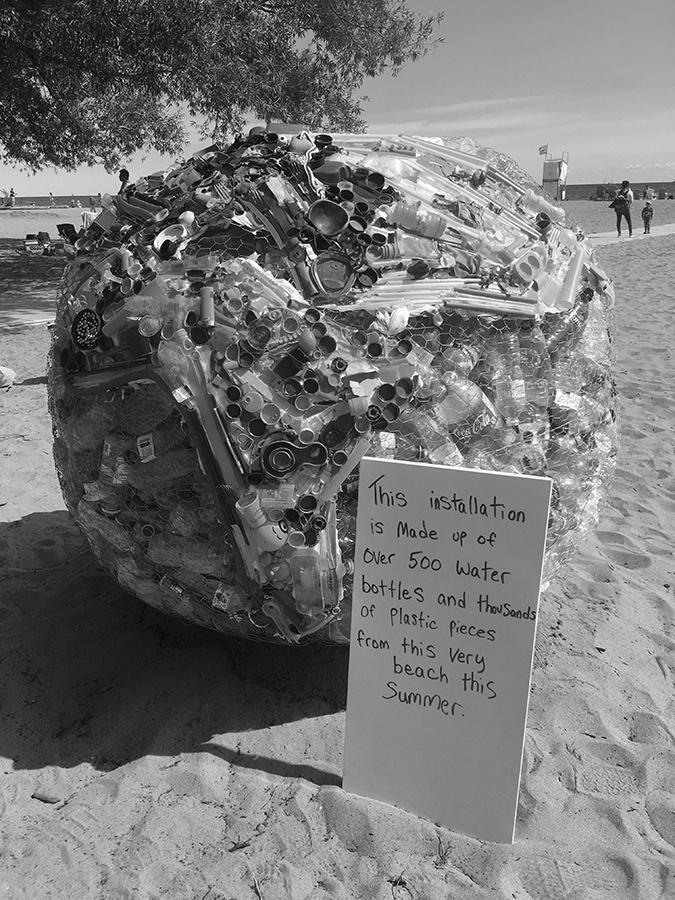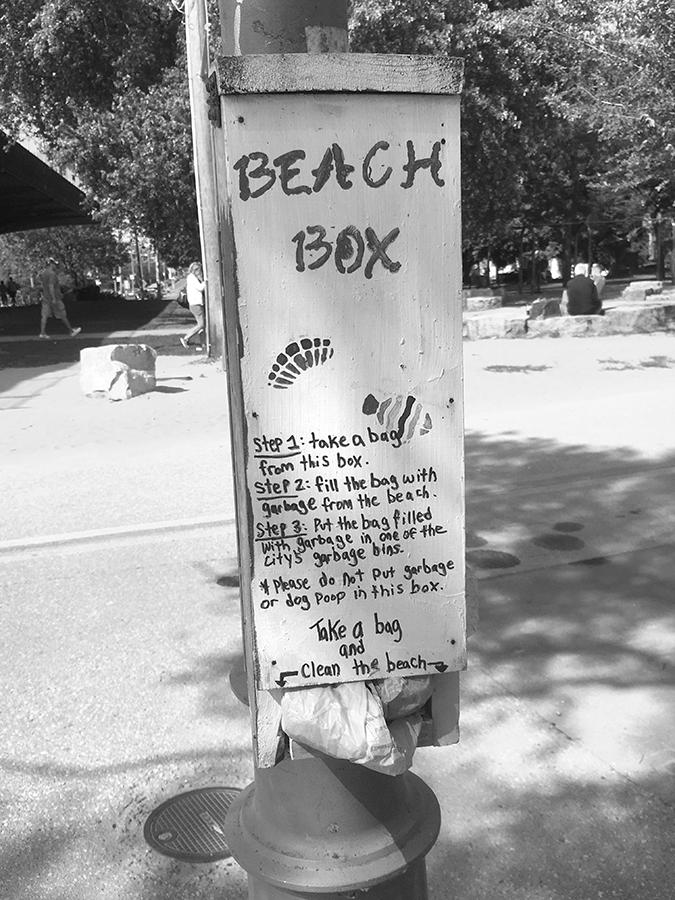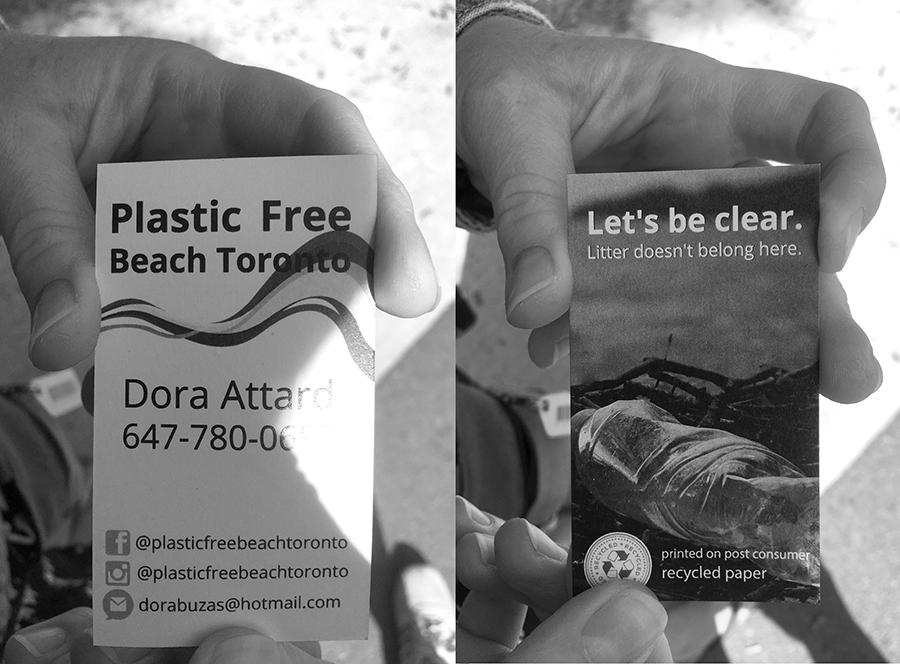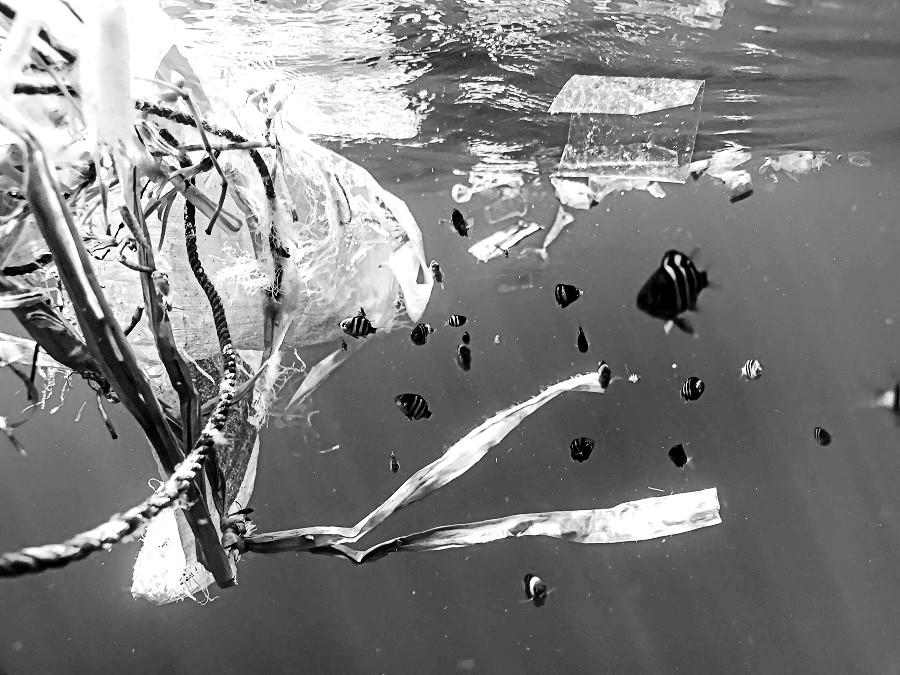Skip the Black Friday this year, pleaaaase!
Black Friday is here again. Millions will spend more than they can afford, buy more than they need, and create a ridiculous amount of waste!
As the last post on Plastic-Free July, we will leave you with various quotes on plastic. Learn and make a change!
Be open and let the world inspire you. Dora Attard inspired us when we met her at Woodbine Beach. Please find out more about her work below.
Since there is not much left of Plastic-Free July, which we prefer to call Plastic-Free Every Day, this is high time to introduce you to a wonderful woman, Dora Attard. Have you ever met a complete stranger in your city whose work inspires you? We did, on a warmish early September day in 2020, our last beach day of the year. It was Sunday, which is why we were able to meet her in the first place.
She is a Toronto resident and a garbage collector. And Dora Attard is also the founder of Plastic Free Beach Toronto. Plastic Free Beach Toronto is an organization that educates people on the amount of single-use plastic that is used and thrown away daily and encourages people to create a cleaner world for future generations.
The way we got to know Dora was so random. As we were leaving our beach day and sending our friends closer to their bus stop, we noticed her giant globe made of trash. It is made from the garbage collected on Woodbine Beach this past summer. In the artwork, water bottles make up the world’s oceans while plastics of different colours make up the continents. We approached her to find out more, and we ended up having a refreshing conversation with her and her friend.
We found out that they have been doing this activity for quite some time. Presenting the beautiful artwork, which she had to install and dismantle every day, wasn’t all she did. Dora is a passionate fighter against plastic. She is bringing awareness to the problem of plastic use, promotes a plastic-free lifestyle, suggests skipping single-use plastic, etc. Plus she organizes garbage pick-up at Woodbine Beach. Since it was the end of the day, we couldn’t participate in this activity, but had a nice chat with Dora.

Plastic is a substance that companies create to make easy money. It may be convenient, but is it worth the huge price that our planet and its inhabitants have to pay? Plastic will outlive us, and that in of itself should shock us. It should be a universal law that species do not leave Earth worse than they found it, that we do not destroy the planet for future generations.
In Canada, just 9% of the plastics collected will be recycled. This number is so ridiculously small. This long-lasting, poisonous material will be here for a long time. Plastic poses the most risk to the waterways. How will the beaches, lakes, rivers, streams, and ponds on Earth look in 5 years’ time? 10 years? 20 years? This is why it is important to deal with plastic now; today. This is crucial so that we avoid problems associated with each time frame in our home country.
We love Dora’s work, that she saw the problem and she took matters into her own hands. What a great way to make a change in your community! She said that the pieces of garbage most commonly found on the beach are cigarette butts, lids and bottle caps, water bottles, and plastic straws. She also finds needles, which humans and animals may step on or they may be found by children. The above-mentioned quite large plastic pieces are not the main problem. “The majority of the little bits I find are washed up from lake that has been broken down in microplastics. They’re eaten by birds and fish, and if you’re not a vegetarian and you eat the fish, then the plastic ends up inside of your body.” Dora stated.
Participate at the Beach Clean-Up Day! It takes place on Sundays from 8-10 AM on Woodbine Beach up until the beginning of Fall. Always be sure to check Dora’s Instagram account for up-to-date information. Please share her handle with your friends and urge them to join you to the clean-up-day, to help keep our beaches clean and beautiful. Dora and her team will provide reusable gloves, buckets/bags, and pickers. The meeting place is out front of the Olympic Swimming Pool.
We are really interested in participating, but since Sunday is the only real relaxing day – read: sleep-in-day – then, unfortunately, yes, this Is the situation. BUT if a miracle will happen and I find myself wide awake at 7 AM, then Dora be sure, I will be there!

Watch a short clip about Dora Attard and her work at CBC.com and read more on the same page.
Watch a video of Dora explaining what is it exactly she is doing in this video.
Visit Dora’s Instagram account Plastic Free Beach Toronto.
Support her work and buy her plastic artwork from Etsy.

We have been consciously plastic-free for 3 years. But we still hate it, so we are curious if there is a way to make peace with plastic.
We came up with a quick and short way of getting our messages out there. Let this plastic detox post be the first of its kind!
Most likely not, but July allows us to bring more attention to a (useless?) material, which is polluting our world in every field of the world.
We are literally drowning in plastic and most of it is absolutely useless. It found its way to our home as a wrapper around so many products. The main task of plastic is to offer a case in what we are bringing food home. Or something else like beauty, cleaning and household products, most of the things really. It almost seems pointless to talk about the useless plastic we are trashing daily.
It is a unique material with many benefits.
It is:
So all this makes plastic a valuable material for many functions. Ir provides environmental benefits, as believe it or not, it actually plays a critical role in the food industry. It helps to maintain food quality, its safety and helps to reduce food waste. Though it hurts us to see produce packed in plastic, most of the time excessive, it ables for the products to reach to the stores and our homes safely and fresh. Of course one can skip the plastic while buying local and visiting farmer’s markets. But as plastic is convenient, so is shopping at the grocery malls.
Even if we consciously are thinking of bringing less plastic home, it lurks in some little-known places. You can look around in your home, and not go that wild, as Werner Boote did. He bought out all the items at his home, which were made of plastic. And he set them on his lawn. Take a look at the photo and find out about the 2009 documentary here. So these are the most common items you can find at home made of plastic.
We all have most of these listed items at home. Can we live without them? Sure! Though it is difficult we can make wiser choices and eliminate as much as we can.
What we all can do to create less garbage, or at least bring less of it home, is to choose plastic-free items. Yes, not only products, which are wrapped with a material that is having a negative impact on our oceans and wildlife. But also products which are made of useless plastic. People tend to create more waste in high-income countries. So it should be also easier to implement the changes in such places. If you are in North America, when reading this, please do your part.
Here is a list of materials to choose over plastic:
Choosing these materials over useless plastic, which is so over-produced, because it is cheap and relatively durable, you will start seeing less plastic in your home. By choosing the above-mentioned materials you are already making the world a better place. A tiny step at the time. Based on where you are located the management of plastic determines the risk of plastic entering the ocean. High-income countries have quite effective waste management systems. So only a little will end up in the oceans. Worse is the situation in middle- and low-income countries. Because they are the main sources of global plastic pollution.

There are many easy swaps on how we all can start to cut plastic pollution. This is a small, but great step to make us feel good and do our part. Start with the basic manageable swaps, which are helping cut down the plastic use.
We suggest you start with the easier swaps, as listed above first and then move to the harder ones. Also, do not be afraid of reusing. This also helps to save items and helps to create less plastic. Some swaps are much easier to make than others — but you can definitely tackle the harder ones if you challenge yourself. Approach playfully and while looking for plastic-free options opt for cheaper options, so you can save more and buy other plastic-free items. Plastic-Free-July is here to provide much-needed information about (useless) plastic and how to avoid it.
Read more detailed suggestions from a wonderful article Learn Earth Easy has written and get more swap ideas.
We can’t help but notice as July is approaching that it is time to celebrate Plastic-Free July. We have a complicated relationship with plastic for some years. I mean we are not buying plastic things and if we want to buy something, we consider where it is made and of what it is made and then reconsider. The beginning was hard, but since we love challenges, we did it. It is the right moment to check the Plastic-Free July to-do sheet and be determined to keep your promises. Share THIS SHEET with your friends to make it more fun!
But on a more serious note, unfortunately, the trade-offs between plastic and substitutes are complex. As earlier said plastic is a good material to use in the food industry for example. As it is essential for the prevention of food losses, wastage, and contamination. Storage and packaging play a crucial role from harvest all the way through to the final consumption of the foods we eat. Even if some consider the final phase of packaging (from retail to home) to be unnecessary, it is likely it has played an important role in preserving food from the farm to the retail stage.
So, plastic may not be so useless then after all. And perhaps the main solution here is to close down plastic-producing plants. One by one. As otherwise, our best efforts seem like taping the crumbling wall with pieces of tape. Or should we do anything at all?
After watching this video – you will know more than enough about Tru Earth laundry eco-strips and you will be sold. We definitely are!
We do not buy much plastic, as we know about its health hazards. But this new discovery about peanut butter in plastic containers blew our minds!
We are on our neverending path, getting to know more what things consist of. Join our adventure on finding thin plastic lining.
After we got into eliminating plastic from our lives, we started to find it from the places, we never thought plastic would be at. Of course, research is always very helpful, as from some places you would never find the thin plastic lining on your own. Or you would if you are a real detective 🙂
I know that this path we are on now is a path of never-ending discoveries and knowledge obtained. Also on a path of exploring more recipes with the somewhat limited variety of regular grocery stores offer in their produce section.
When we started this plastic-free, minimalism, less consuming adventure, we both thought: “Yayyy!, we skip the plastic containers and buy cans, glass, and paper-wrapped foods. Especially important for us were the tin cans, as we know that they are recyclable and even if left in nature they will degrade. But while the other day doing research while writing another post I came across a little Tweet: “Most of the tin cans have plastic lining!”. I was alarmed. What, I have never seen it or most likely not noticed.
Next time after that discovery, when I was cooking I opened two cans: red kidney beans and chopped tomatoes in their own juice. The latter had indeed the white coating, most likely epoxy resin. Wow, I was fooled and I was blind….but at least hopefully I can help some others now on their way of seeing things they way they are.
I think it applies mostly where you are coming from, as I think in North America tin cans are lined with plastic more than in Europe. But nevertheless where you are located at the moment, please do check your tin cans during your next cooking adventure. Tins are plastic lined either with a polymer (plastic) coating or epoxy resin (also plastic) and this applies for food, drink, and even cosmetics.
Aluminum drink cans have a polymer plastic lining. It’s there to stop acids in the beverage from corroding the metal which is not good for the can or the flavor of the contents. Rust is can’s number one enemy – and a can’s only defense is an invisible epoxy shield, just microns thick. A can of Coke (who drinks that anyway?) without that shield, would corrode in three days. You really can’t see, as it is behind the colorful design of the can.
I am not going to fall deeper how you can get to expose that lining and instead I welcome you to look at Steve Sprangler showing his discovery live on a TV show. Who would have known, uh?
Nearly all tin cans are plastic lined with epoxy resin. This is used because of its exceptional combination of toughness, adhesion, formability and chemical resistance. These coatings make it possible for food products to maintain their quality and taste while extending shelf life.
In tins, the liner can be white or yellow or transparent in which case it is undetectable. In most cases, it is best to assume that any cans that you get your hands on have a plastic liner. The lining prevents canned foods from becoming tainted or spoiled by bacterial contamination.

Tins used to store cosmetics are also lined with epoxy resin to prevent corrosion.
So now you are probably wondering, wait, what about recycling, were you fooled all the time? But what is happening, when the can is recycled, the plastic lining is burnt off.
Many every day things contain plastic lining, which we are oftentimes not even aware of. Knowing that these items are made of plastic, should also help you perhaps making a decision, whether you continue using them or putting them at the right place.
Read more here about, where else you can find plastic.

What does it mean for your health then, you may ask. The lining contains Bisphenol A (BPA) a chemical building block that is used to make polycarbonate plastic and epoxy resins. Unfortunately, BPA is toxic and does leach from plastic liners into the food. BUT, another but, the amount does matter, as the dietary intake of BPA from can coatings are non-existent and there should be no fear to exceed the safe level of BPA, even if you would eat the contents of 10 or even 100 cans in one day.
Unfortunately, BPA does more than make plastic plastic. it interferes with hormonal biology. Biologically speaking, hormones are rare, and potent. The system that produces, stores, and secretes them – the endocrine system – controls hair growth, reproduction, cognitive performance, injury response, excretion, sensory perception, cell division, and metabolic rate. Endocrine organs – including the thyroid, pituitary, and adrenal glands – produce particular molecules that fit into particular receptors on cells, unleashing a chain of biochemical events.
Hormonal changes in infinitesimal quantities cause dramatic changes, including diabetes and hermaphrodites. Endocrine disruptors like BPA get jammed in the cells so that the real molecules can’t get in there and do what they should. Others fit perfectly, triggering events the body didn’t intend to initiate. Because of BPA, everybody dances around what to call the can’s internal corrosion inhibitor. The FDA calls it a resinous and polymeric coating. At Can School, Ball employees called it an organic coating, or water-based polymer. The EPA calls it a chemical pollutant. Health researchers call it an endocrine disruptor, and a chronic toxin.
**This paragraph is directly from the Wired article “The secret life of the aluminum can, a feat of engineering”
In the end, the choice is yours – are you boycotting all tins and cans after reading this? We are not using canned food much. We are buying only tomatoes, coconut, and beans in cans. Unfortunately, most beans do not come in a glass jar. In our case, when we are living fridge free, cooking a batch of beans for an hour is not really environmentally friendly anyway.
We are not consuming soda drinks and if we buy any drinks, then we try to buy them in a glass,
This post is an indirect reference from the wonderful plasticisrubbish.com
*Pictured is a tin can of kidney beans. The lid’s plastic lining is scratched off with a knife.